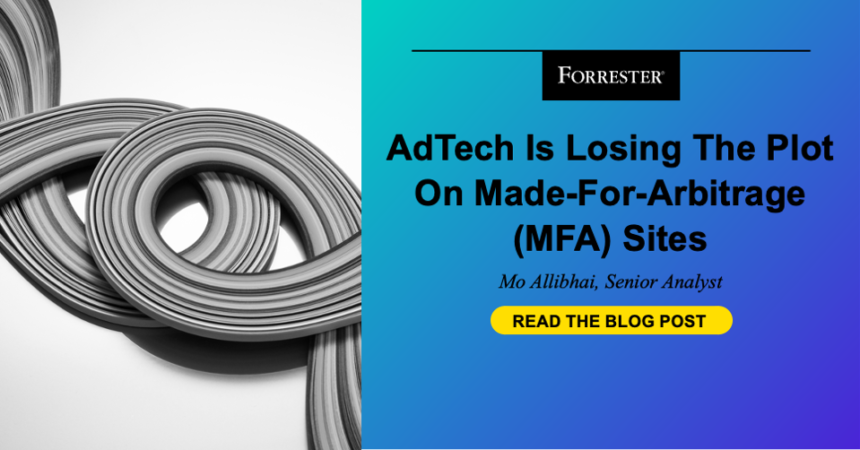Last week, Forbes was accused of misleading major advertisers with a spoof of its own website – www3.forbes.com. The company created the site in 2017 as a subdomain, stretched its own content to fit more ad formats (e.g., turning 700-word articles into 34 slides), and sold advertising on this made-for-arbitrage (MFA) site to brands that believed they were buying legitimate ad space on Forbes.com. Forbes collected as much as 25% in additional ad revenue from the site, and five of the affected advertisers said that between 10% and 28% of the ad impressions they had bought on Forbes.com since 2022 had appeared on the alternate site. Following inquiries from The Wall Street Journal, Forbes shut down the site, and Forbes ads on Outbrain no longer direct to www3.forbes.com.
How Common Are MFA Sites?
Though Forbes shut down the subdomain in question, MFA sites abound. These sites typically feature generic content, poor web design, high ad-to-content ratios, and rapidly refreshing ad placements. The ANA estimates that MFA sites take in over $10 billion annually, accounting for over 10% of all open programmatic spending and 40% of wasted ad spend.
Moreover, many high-value ad-supported experiences follow the MFA trend — consider Google’s search engine results page, where organic search results are buried far beneath the fold, and before scrolling, users see a litany of paid advertisements and no original content (many of which are fraudulent and to be avoided, per the FBI). Amazon, too, the FTC noted, quadrupled the percentage of ads in its mobile search results — an Amazon exec allegedly said the company “would be crazy not to,” even if it wrecked the user experience.
The Real MFA Dilemma
Because users are still present and attentive on MFA sites, they continue to suck up advertising budget. And thanks to generative AI, more websites with more content than ever are being launched into the programmatic ecosystem every day, while good publishers unintentionally get swept up in the fray. We know which websites are MFA because there’s a list of them. But knowing isn’t enough to eradicate the problem because of misaligned incentives in the adtech ecosystem. Specifically:
- MFAs are consuming programmatic budget because they are likely generating ROI. DSPs would not continue to purchase these ads at these rates if bidding algos did not determine that they were performant. While it’s possible that a DSP may be optimizing bids for the wrong KPIs, the more likely reason a DSP algo continues to buy this inventory is that it continues to deliver on campaign goals based on some combination of performance and reach.
- Many advertisers optimize viewability without regard for ad experience, so publishers are incentivized to follow suit. Viewability is often considered a KPI that advertisers should maximize, but 100% viewability suggests the worst possible ad experience — an unskippable full screen. Yet many publishers feel the need to focus on keeping ads in frame for a “viewable” length of time, instead of delivering an uncluttered and engaging user experience.
- Since paid demand generation is all about quantity, publisher monetization of that traffic is unlikely to focus on quality. Paid demand generation is a necessity, but the quality of that demand varies widely. Companies like Taboola and Outbrain appear to generate demand but saddle customers with vast quantities of poor-quality, indiscriminate traffic, which further incentivizes MFA behaviors. A mix of traffic sources necessitates a less single-minded focus on monetizing a particular type of user and draws publisher attention to more virtuous cycles like organic growth and user retention.
- Lax SSP enforcement and incentives for dishonest behavior creates an environment where good publishers do questionable things. One issue advertisers have with MFA is usually that it’s valid by all common standards. In this case, advertisers (via their DSP bidding algorithms) believed they were reaching audiences on www.Forbes.com. While the result is akin to Gannett’s “human error” back in 2022, this incident again demonstrates that SSPs may be sleeping on the job when it comes to publisher misbehavior.
Advertisers Must Abandon Blind Programmatic Buying
In 2024, machine-generated content and ad-saturated content are becoming very much the norm — many of the most reputable news sites from the largest media companies in the world are frustratingly, distractingly ad-dense. Advertisers need to make decisions based not on why the content was made but on whether a qualified user’s attention might be engaged by a display ad placed there. In the case of Forbes, direct and PMP advertisers and programmatic buyers each had their trust compromised.
For advertisers to address the heart of the issue — that they want to place ads on high-quality websites that capture users’ true, engaged attention — they must abandon blind programmatic buying.
For publishers, too, the MFA faux pas is instructive: While some demand generation sources offer the “cheap high” of surplus traffic, that yield comes at a hit to trust that’s been built up for decades, in the case of Forbes’ print and digital publications. Any publisher looking to curate a new content experience must customize the content to make it more engaging and user-friendly (a task that today’s AI makes significantly easier), properly identify the URLs as part of the parent domain, and evenly attract and scrutinize traffic from all demand sources.








